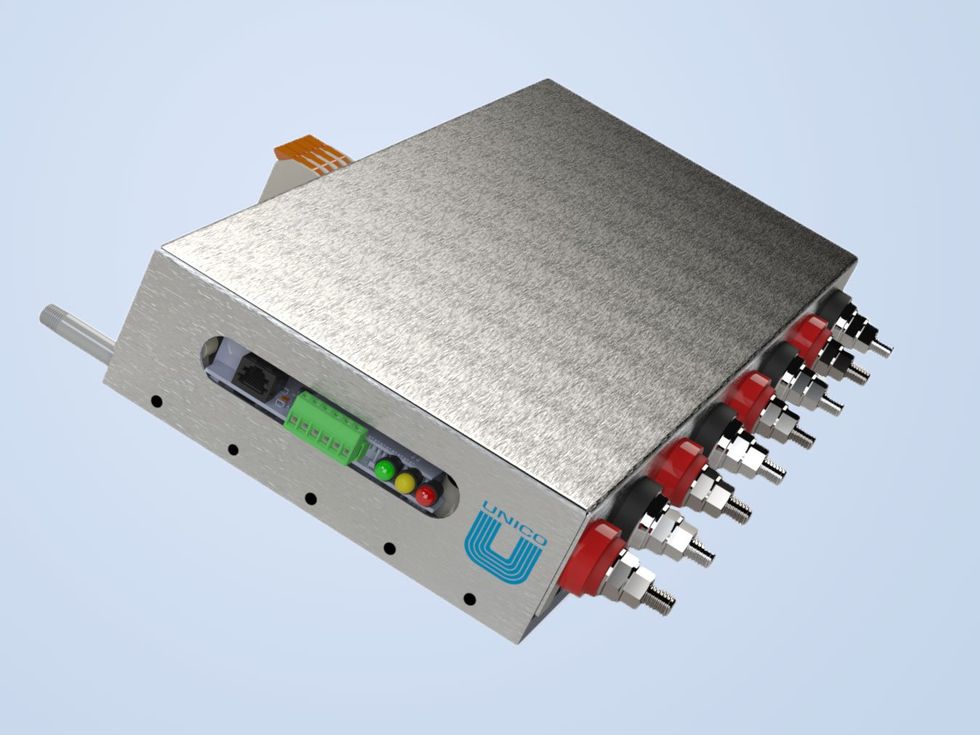As EV production and, with it, battery production accelerate over the next decade, so too will the demand for rigorous EV battery testing. But producing a battery that will stand up to the task of powering an electric vehicle for years under different weather conditions and unpredictable usage patterns is no mean feat. Battery manufacturers will have to turn out many more units suitable for EV demands while still performing the array of tests they must carry out to assure automakers and consumers that the batteries they’re turning out meet basic standards for performance, safety, and durability.
At the International Battery Seminar & Exhibit held 12-15 March in Orlando, many of the world’s leading battery makers, test equipment manufacturers, and theorists gathered to talk about advances in the field and to present new products claiming to make the battery production process quicker and cheaper. One such product family was the BAT300 series electric power testing devices made by Unico.
Unico says the compact units are well suited for use at three critical battery-production stages: cell formation; fault testing as cells are gathered into packs and packs are gathered into full batteries; and for end-of-the-line charge cycling to help predict how many charge-discharge cycles a battery will go through before it is no longer capable of holding enough charge for vehicle propulsion. Unico vice president of engineering Don Wright told IEEE Spectrum that the BAT300 series is also good for conducting capacity tests when a company wants to check cells it purchased from another manufacturer.
“Battery companies have expended enormous effort on predictive modeling.” —Paul Kohl, Georgia Institute of Technology
At the battery seminar, Wright showed off a BAT300 test channel designed to convert a 400 or 800 volt direct current down to a 10 volt current for cell formation or cell testing. The potential benefits of Unico’s product are significant enough that it was named a finalist for the battery seminar’s “Best in Show” award.
But important questions remain. “It may be a wonderful product. But it’s such a complicated set of things [Unico] is claiming,” says Paul Kohl, a professor at the Georgia Institute of Technology’s School of Chemical and Biomolecular Engineering in Atlanta.
“Does it really do all those things?” says Kohl, whose primary research interests include advanced interconnects for integrated circuits and electrochemical devices for energy conversion and storage including lithium-ion batteries and alkaline fuel cells. “If it did any one of those things really well,” says Kohl, “that would be amazing.”
“Battery companies have expended enormous effort on predictive modeling, trying to be able to forecast when a battery will reach the end of its service life without having to cycle test it to that point,” says Kohl. “They’re all very private about exactly what they do, but everyone does pretty much the same thing. They cycle batteries and look for signatures in the current and voltage which follow a trend. And they’ll take a few batteries all the way to the end of life, then use that empirical data for extrapolating to the end of life for the thousands of other batteries that they put through only a few cycles.”
Big manufacturers already have battery testing tools
The open question is whether Unico’s product does it better than the tools major battery manufacturers such as LG or Samsung already use. There are thousands of publications about this, including plenty sponsored by the U.S. Department of Energy. “Does Unico have something that is somehow better than what everyone else has been doing?” Kohl says. “Only the market will tell.”
Kohl says the BAT300 series might be wonderful for battery manufacturers which are not on the scale of LG or Samsung: ”Companies that are, by far, the world’s experts in how batteries age,” he says. Smaller companies that don’t have the in-house expertise the giants have acquired would suddenly have an advanced tool that can raise the quality of their batteries.
“It would take a lot of faith for you to do a simple electrical test and guarantee that nothing bad will happen if you smash this battery with a hammer.” —Paul Kohl, Georgia Institute of Technology
Though electric vehicle batteries rarely catch fire—at least compared with the propensity of fires in vehicles with internal combustion engines—the conflagrations caused by cheap, knockoff batteries at the low end of the EV market have engendered a somewhat unwarranted wariness about the relative safety of EVs. Kohl and Wright agree in their hope that equipment like Unico’s will help bring an end to companies buying or selling batteries that have not undergone testing protocols that make EV battery fires even more of a rarity.
Still, Kohl points out, “In this unit they presented, they can only do so much. It can do an electrical test, looking for certain signatures that indicate issues that could cause electrical faults or premature loss of capacity at some later time, but [it doesn’t carry out] the array of Underwriters Laboratory–style physical tests where they pound batteries, heat them up, and drive nails through them to see what it takes to get them to catch fire or otherwise fail. It would take a lot of faith for you to do a simple electrical test and guarantee that nothing bad will happen if you smash this battery with a hammer, or if it gets into a car accident, or the temperature goes up to 150 degrees Fahrenheit.”
Better battery testing tech could jumpstart the used EV market
To be fair, Unico says that the BAT300 series is intended for applications where expensive, research-level tools deliver more than what’s needed, but cheap, entry-level tools don’t do quite enough. One possible application is the used vehicle market. Once cars have been driven off of car lots, tests that call for physical abuse are out of the question. That is the point at which detailed but straightforward and reasonably-priced electrical analysis would be indispensable.
According to a study done by the United Kingdom’s Society of Motor Manufacturers and Traders (SMMT), the country’s used EV market, though tiny today at 1.6 percent of sales, will eventually be as large as today’s used car market for vehicles with internal combustion engines, which accounts for 82 percent of sales. “ Different makes and models test in different ways, so an individual manufacturer would struggle to test any other vehicles which their dealerships might sell after a trade-in,” says Alexander Johns, partnership lead at Altelium, a consultancy headquartered in London that provides warranties and insurance to companies that deal with batteries at any stage in their life cycle.
Altelium also conducts battery health tests and issues battery health certificates that present an honest broker’s perception of what an electric vehicle should sell for on the secondary market. Because of the wide variance in how batteries are set up in electric vehicles, says Johns, “the [secondary] market is adopting third-party solutions which could offer nearly universally applicable test services.”
That’s a sweet spot which seems like a natural fit for tools like the ones Unico produces. Perhaps insurers like Altelium will use tools like Unico’s to certify the capacity of EV batteries and tell a would-be purchaser the estimated number of remaining charge cycles before a car’s battery will need to be replaced. That all-important data will be critical to setting a purchaser’s expectations and go a long way toward leaving a good impression.





